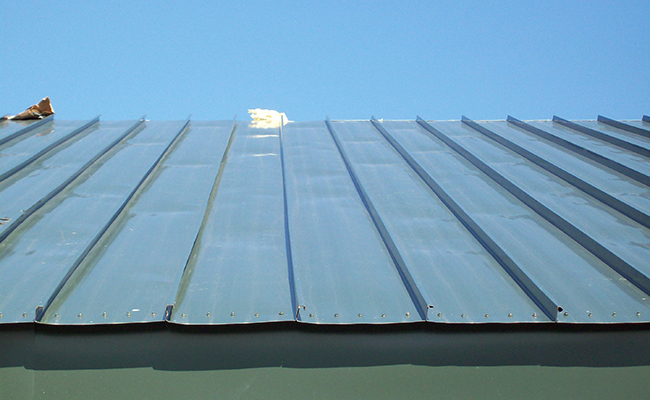Oil canning is defined as the visible waviness in the flat portion of a metal panel. Oil canning is a visual issue, not a weatherproofing or performance issue. However, building owners will complain about waviness in metal panels on roofs, walls, and perimeter edge metal. Edge metal and metal wall panels are more of a concern than low-slope metal panels because edge metal and wall panels are visible from the ground. Steep-slope metal panels and shingles are also visible, so awareness of potential oil canning is important.
What Causes Oil Canning?
Oil canning can happen when unwanted stresses are introduced at fasteners, clips, and over purlins and uneven substrates. Over-driven fasteners, clips that are slightly misaligned relative to the clip/seam interface, and too much insulation between the purlins and panels can introduce these unwanted stresses. A misaligned panel or edge metal clip, certainly after the seam or drip edge is crimped tight, will add stresses to metal panels and edge metal
Tips to Help Prevent Oil Canning
- Place clips correctly: Setting clips in the proper location for edge metal and metal panels (roof and wall) is critical. The clip needs to fit into a panel seam without forcing the vertical seam out of plane. The clip needs to be aligned correctly and sized appropriately to not compress the vertical portion of the seam. Clips that secure edge metal need to be positioned correctly so that crimping the drip edge won’t twist or bend the edge metal.
Although not highly visible, low-slope structural panels can oil-can at clip locations and where insulation is draped over purlins. Compressed insulation at purlins can “push back,” adding stress to the panel and resulting in oil canning. - Consider the roof color: Sometimes oil canning is inevitable. The color of the metal or coating won’t really make a visual difference, but darker colors panels will heat up more in direct sunlight. This may make oil canning worse in some cases. However, striations and small ribs (which also add strength) may help prevent or hide oil canning.
- Choose a thick metal: Metal thickness matters, so specify metal that’s as thick as possible to avoid oil canning. Thicker metals are stiffer, so they may resist deformation due to unwanted stresses. This reduces the chance of oil canning in edge metal and wall panels, which are most commonly smooth-surfaced.
For more information on oil canning and its causes, see the Metal Construction Association’s white paper on the subject, which can be found at www.metalconstruction.org.
Consider these ideas on your next job.
